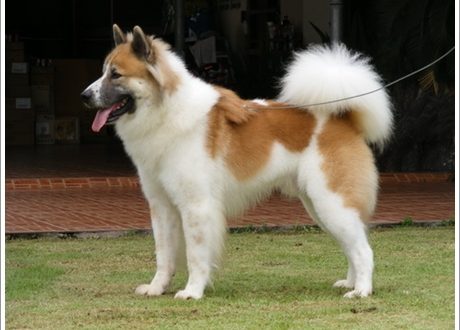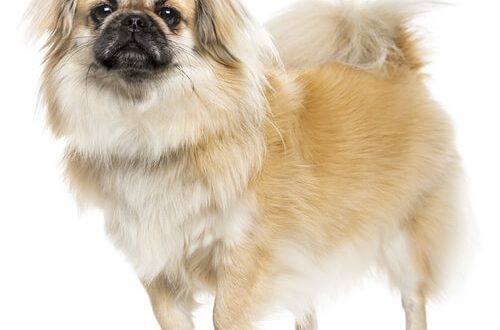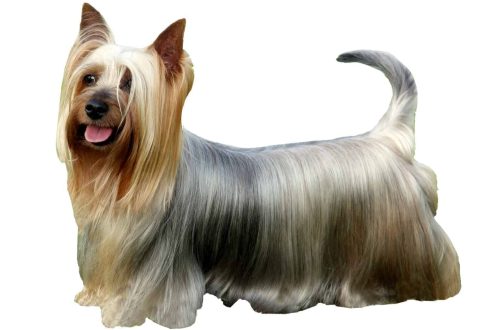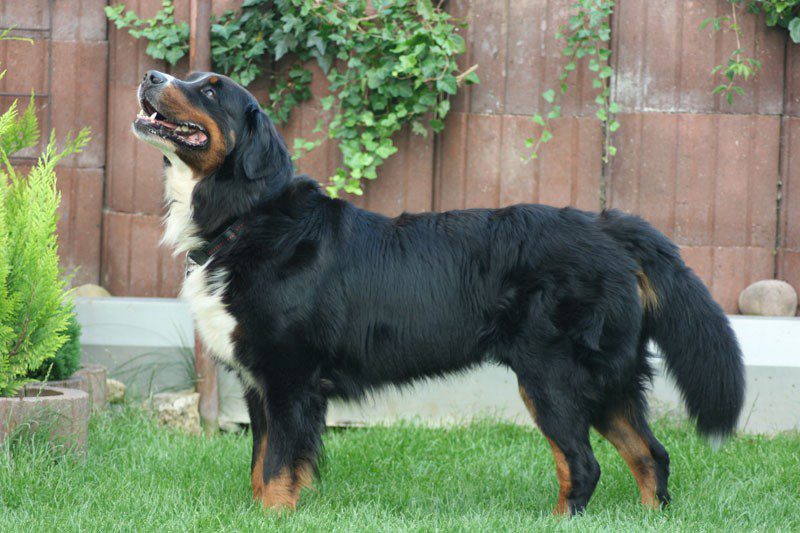
Bernese Mountain Dog
Contents
- Characteristics of Bernese Mountain Dog
- Bernese Mountain Dog Pros and Cons
- Basic information
- Description of the Bernese Mountain Dog
- Character of the Bernese Mountain Dog
- Education and training
- Keeping and caring for the Bernese Mountain Dog
- Food
- Health of the Bernese Mountain Dog
- Story
- Photo of Bernese Mountain Dog
- Who is this breed for?
- Famous dogs
- How to choose a puppy
- Photos of Bernese Mountain Dog puppies
- Owner’s personal experience
- Bernese mountain dog price
- Bernese Mountain Dog – Video
Characteristics of Bernese Mountain Dog
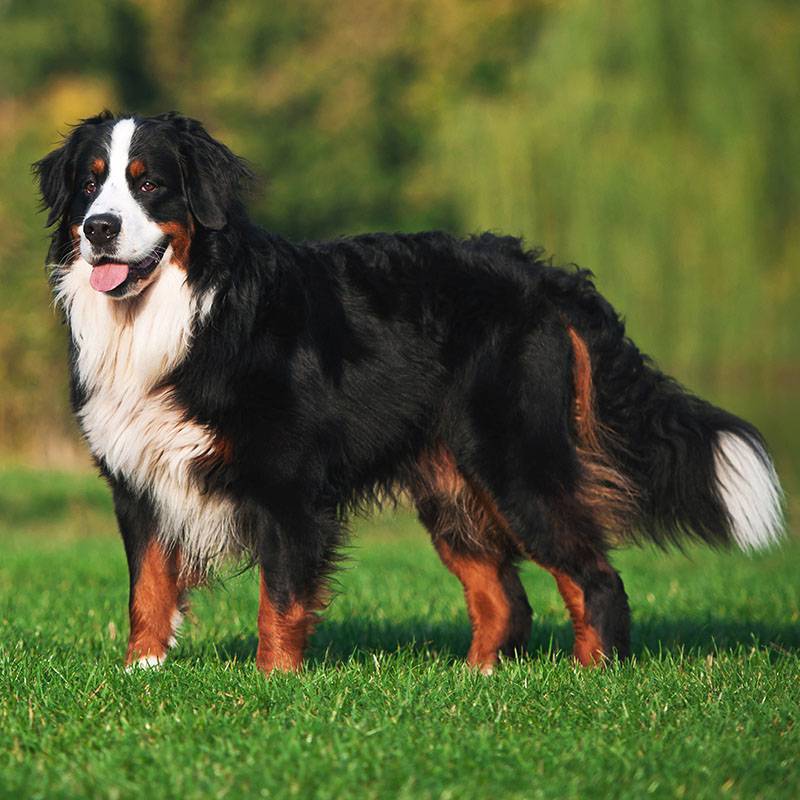
The Bernese Mountain Dog is a large dog with a calm disposition. Able to become a great friend for a person of any age.
| Country of origin | Switzerland |
| The size | large |
| Growth | 35-50 kg |
| Weight | 60-70 cm |
| Age | 12-14 years old |
| FCI breed group | Pinschers, Schnauzers, Molossians and Swiss Cattle Dogs |
Bernese Mountain Dog Pros and Cons
| PROS Learn new commands quickly Lack of aggression, both to all members of your family and to strangers; Not afraid of cold climate; obedience. | CONS The need for regular brushing Slowly mature – up to two years; Cannot be alone for a long time; Heat intolerance. |
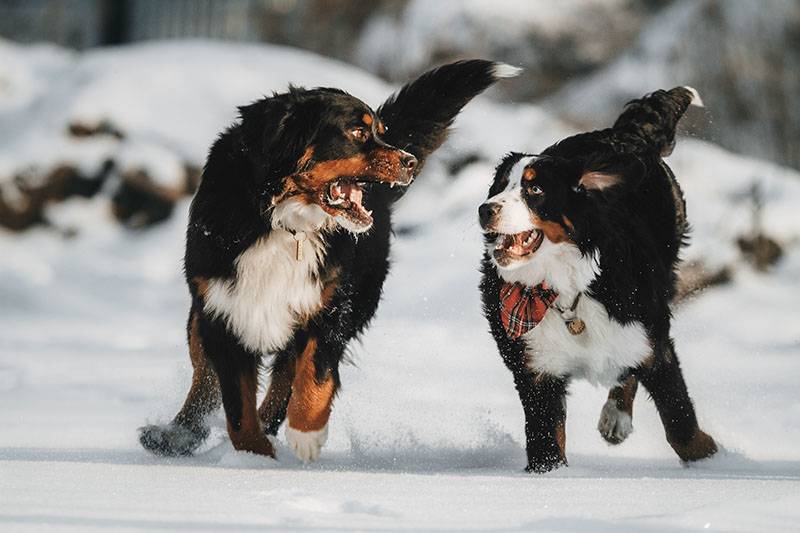
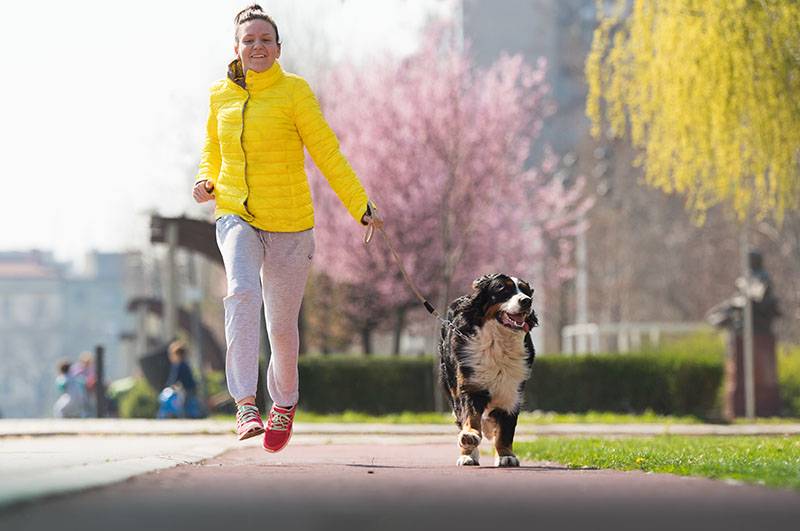

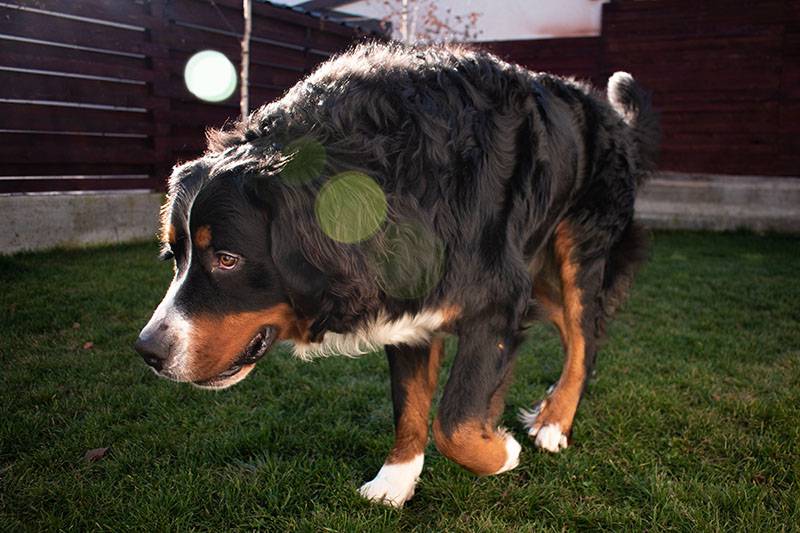
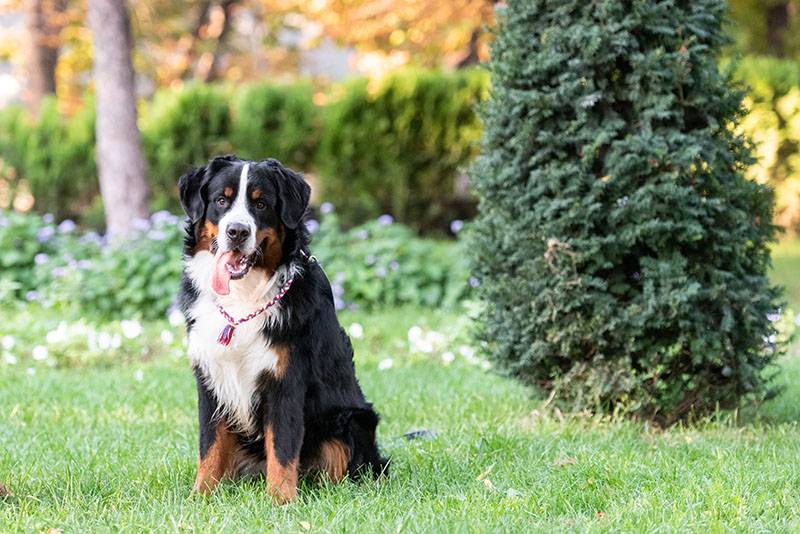
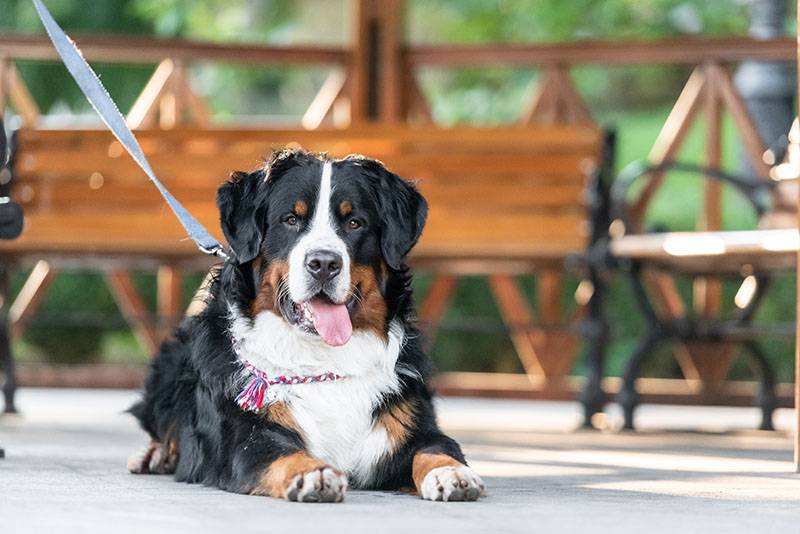
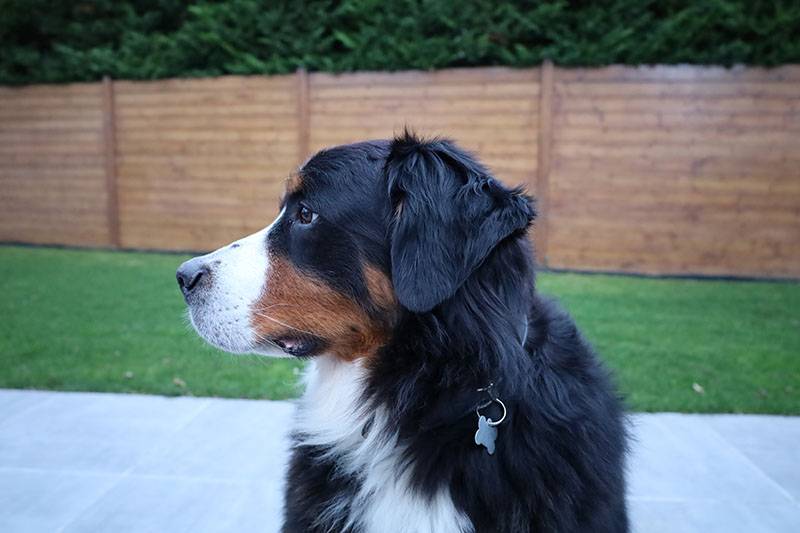
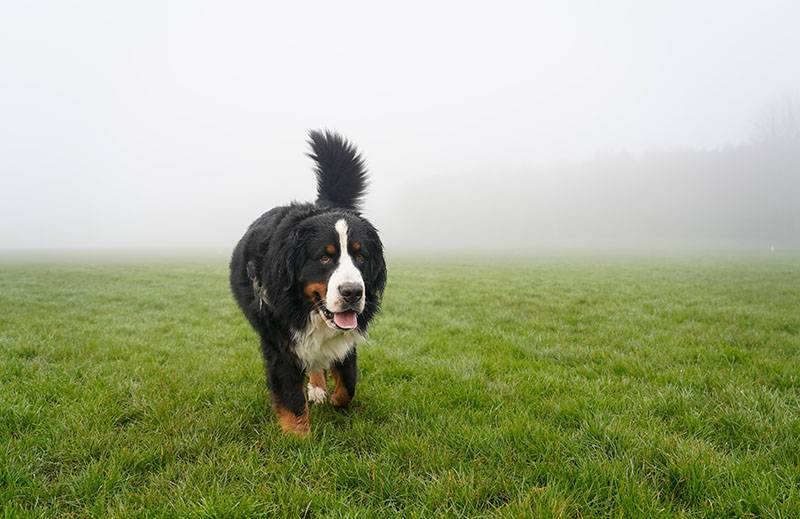
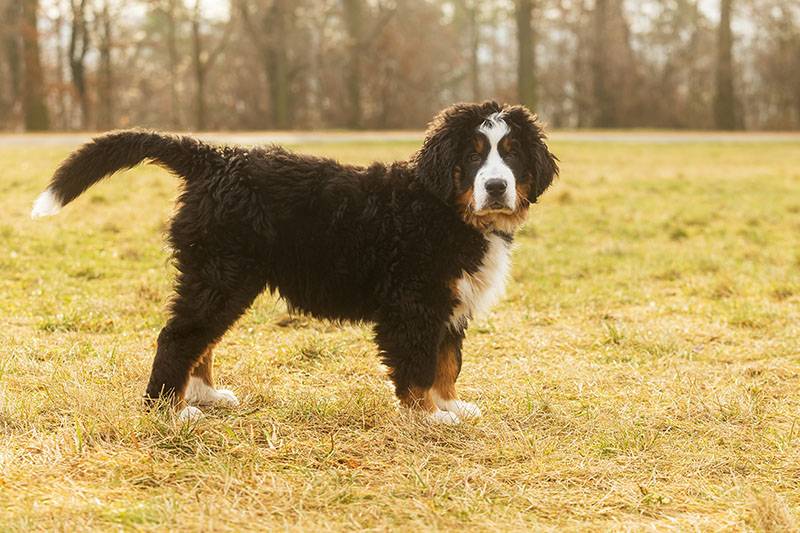
Basic information
- The Bernese Mountain Dog gets along easily with any other pets.
- Due to natural slowness, they do not always react with lightning speed to the owner’s commands
- Security qualities are well developed, but the dog will never attack without a good reason.
- In order for such an animal to maintain good physical shape, regular exercise is necessary.
- Can be a good babysitter. However, it is not necessary to leave children with a dog for a long time. A large pet, due to its sluggishness, is able to inadvertently push the baby, harm him
- The Bernese Mountain Dog is highly sensitive and reacts very painfully to a change in the owner’s tone of voice. Therefore, it is not recommended to scold him.
- There is a predisposition to certain diseases, in particular, problems with the musculoskeletal system can often appear.
Description of the Bernese Mountain Dog
These pets are large. Their coat is voluminous and dense. Undercoat is present. Coloring is allowed only tricolor – black with reddish-brown tan and white spots on the head, neck and paws. Short hair is considered a marriage.
Males always look much larger and more masculine than females.
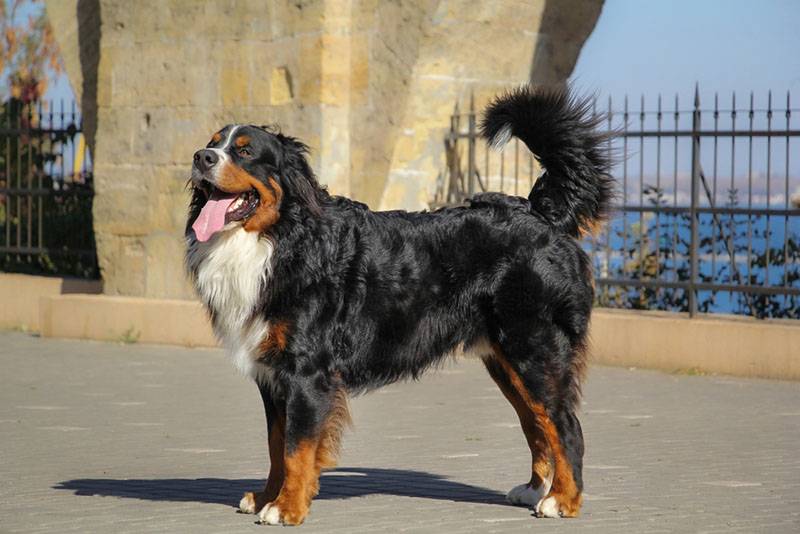
Head
The Bernese Mountain Dog has a large head. Fully proportional to the body. The widest and flattest place on the skull is between the ears. The muzzle has an elongated wedge shape.
The nose is large, its color is always black. The lips are dry, close to the jaw strongly, with pronounced black pigmentation. Flights are absent.
The bite is powerful. Ideally, it should be scissor-shaped. The direct type is also allowed. The teeth are strong, white, located on the same line. When the jaw muscles are relaxed, the animal appears to be smiling.
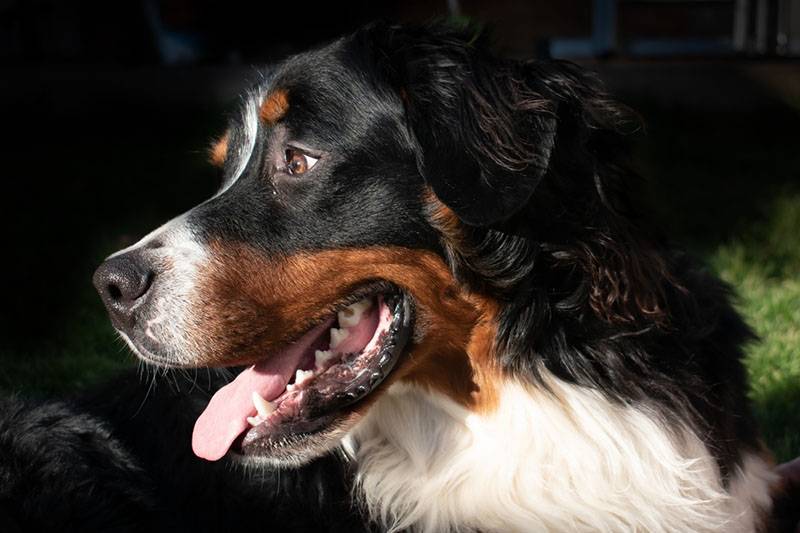
Eyes
They look small. They are almond shaped. Not planted too deep. Their expression is always lively and friendly. Color, according to the standard, can only be dark brown. The eyelids of the Bernese Mountain Dog are dry, close-fitting, with pronounced pigmentation.
Ears
Set high and fairly wide. Their size is medium, shape is triangular. The tip of the ear is slightly rounded. The cartilages are strong and well developed.
In a calm state, they hang, if the dog is interested or alert about something, they rise at the base and turn forward.
Neck
The neck of the Bernese Mountain Dog is of medium length with a dense and dense coat. Looks strong and muscular. The nape is clearly visible. The withers are well developed.
Frame
The body is strong and strong, slightly stretched in shape. The croup is of moderate length and slightly sloped. The back looks straight. The chest is developed, with a pronounced anterior part. Ribs are rounded. The underline is moderately tucked up. The loin is strong and strong, much narrower than the chest. Males have two normally developed testes, fully descended into the scrotum.
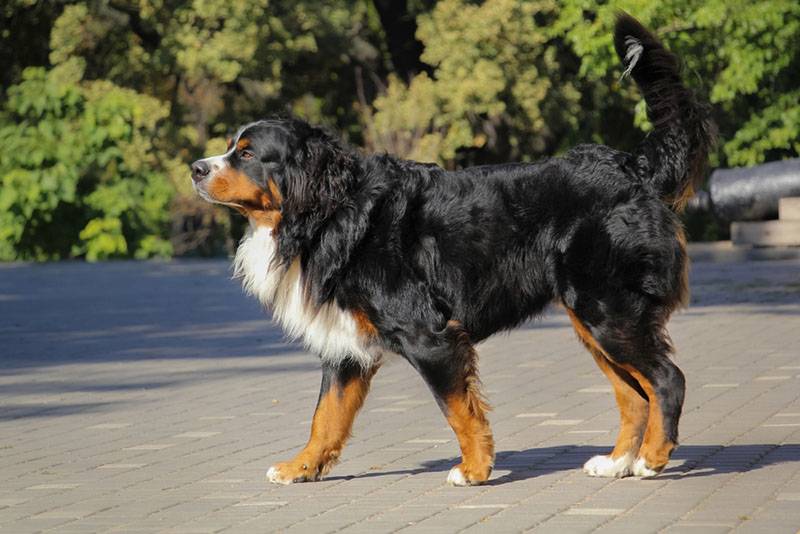
Tail
The tail of the Bernese Mountain Dog of natural shape is saber-shaped. Its base is a continuation of the croup. It narrows noticeably towards the end. The breed standard allows for a length of tail reaching to the hocks. The coat on it is long and lush. In a calm state – lowered, in an excited state – slightly rises.
limbs
They are strong and muscular in the Bernese Mountain Dog. Both front and back legs are straight. The shoulder blades are elongated and tilted back. The elbows are close to the body of the dog. The forearms are straight, with well-developed bones. The pasterns are strong, if you look at the animal from the side, they are on the same level with the forearms. The thighs are broad and muscular. Metatarsus are located vertically. The paws are rounded, the toes are compact, pointing forward. The nails are short. The pads are thick and rough.
Gait
The movements of the Bernese Mountain Dog are strong and balanced. The step is free and easy. The hind limbs perform a pushing function. When walking or running, the legs move in a straight line.
Wool
The coat of representatives of this breed is double. The guard hair is short and lies close to the body of the dog. The undercoat is thick. A slight wave on the withers or back is allowed. But ideally, the coat is straight. Curly hair is a significant marriage. Hair is required.
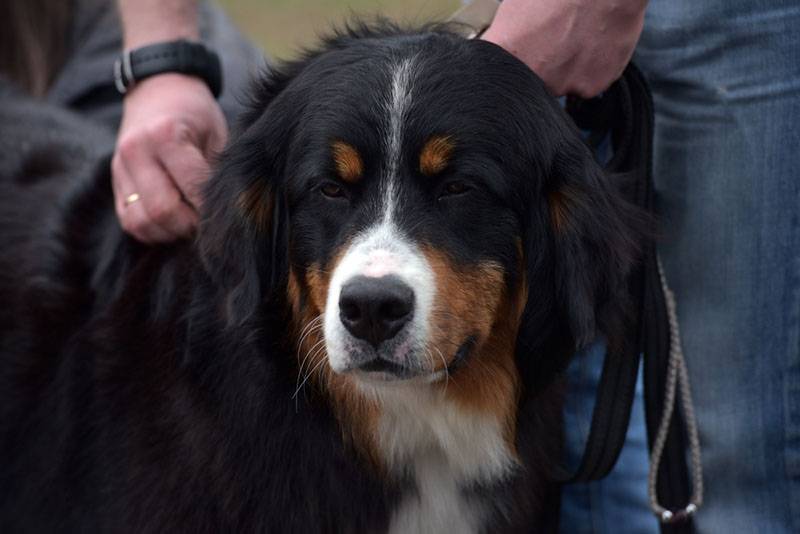
Colors of the Bernese Mountain Dog
The Bernese Mountain Dog must be tricolor. The main color is black. There are white and red-brown spots on the muzzle – above the eyes and on the cheekbones. The presence of marks on the chest, neck and on all four legs is acceptable. According to the standard, colors should be bright, with clearly defined borders.
White spots can be located on:
- Head in the form of a narrow blaze descending from the top of the head to the nose
- Neck
- All four paws
- The tip of the tail.
Undesirable, but acceptable, a small spot on the Bernese Mountain Dog (half the size of a human palm) on the nape.
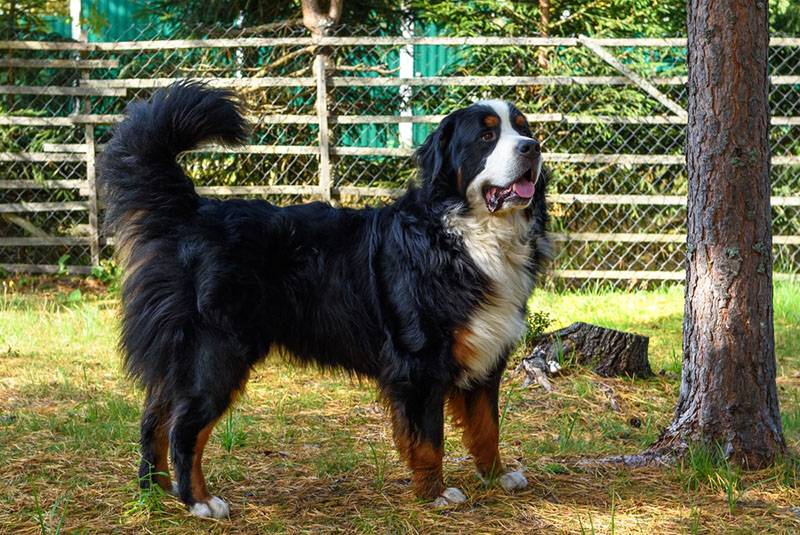
Size and weight
Male Bernese Mountain Dogs are always larger than females. Their height at the withers varies from 64 to 70 cm. The average height of females is from 60 to 66 cm.
The weight of an adult individual can be from 35 to 50 kg.
Character of the Bernese Mountain Dog
The Bernese Mountain Dog is balanced and good-natured. Dogs are friendly and peaceful. They get along well with all pets, never come into conflict with other dogs during a walk. They are not characterized by aggression and a hostile attitude. With strangers behave either friendly or indifferent.
Despite the peacefulness, the Bernese Mountain Dog has a well-developed guard instinct. They are ready to defend all members of their family and their territory if necessary. But the Mountain Dog will not attack without a good reason, he will rather scare the attacker away with his formidable appearance.
Representatives of this breed are very attached to the owner. Usually a dog chooses one owner and remains faithful to him all his life. Separation from him is extremely painful.
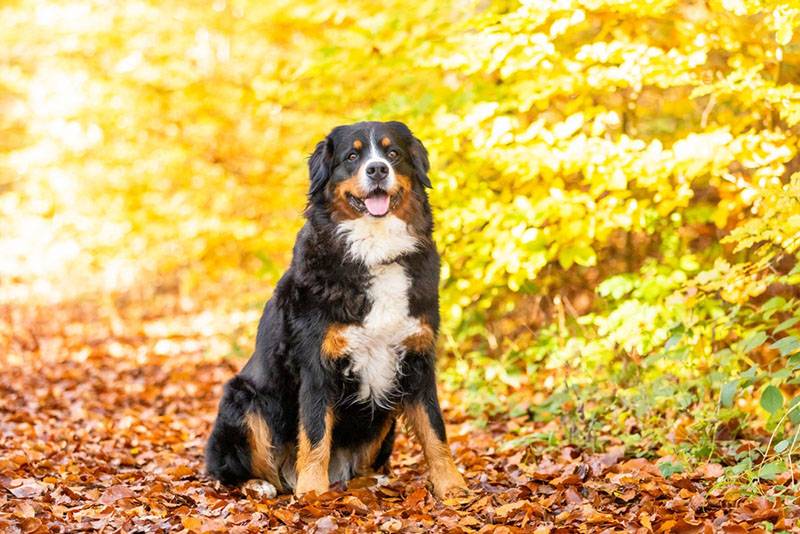
The Bernese Mountain Dog tries to please a person in everything and obediently fulfills any of his instructions.
They are distinguished by increased sensitivity: they easily understand the intonation of a person’s voice and a change in a person’s mood.
Young individuals always behave more actively – they are playful and inquisitive. Adult dogs are more calm, sometimes even phlegmatic.
Bernese Mountain Dogs are patient with children and are ready to endure any of their pranks. Able to become good nannies. But in any case, you should not leave them alone for a long time unattended with a child.
Education and training
Training begins from the first days of the appearance of the baby in the house. First of all, the puppy should understand who his owner is. To do this, it is recommended to perform a special exercise – to establish eye contact with the dog. You need to sit opposite the pet and look him in the eye. When the Bernese Mountain Dog fulfills the requirement – to meet the eye of the owner – he is sure to be treated to a delicacy. Training should be regular, preferably several times a day.
Also, the puppy must be taught to respond to its name. It is constantly repeated in a clear and loud voice. If he responds and comes over, encourage him by offering a treat or favorite toy, for example. The more often such training is carried out with the baby, the faster he will remember his nickname.
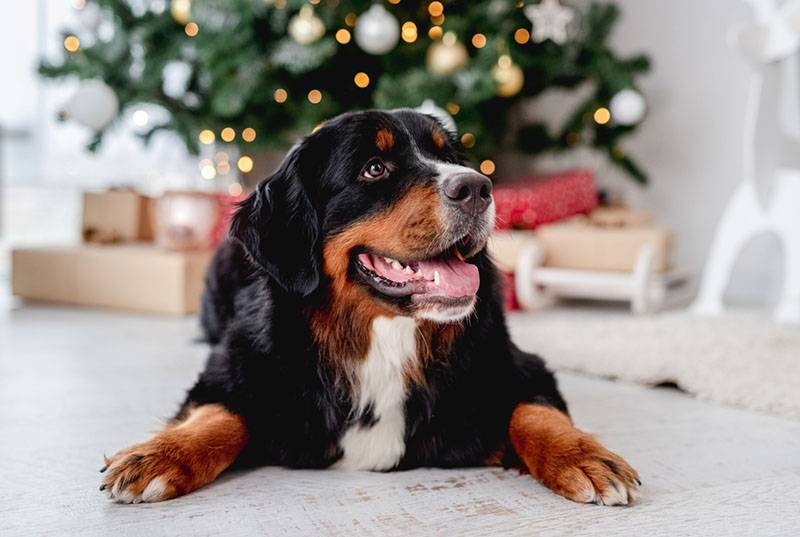
You need to be active with your pet. Until the animal is fully grown up, training takes place in a playful way, it is desirable that it be varied and short-lived. The recommended time is 10-15 minutes. Only after the Bernese Mountain Dog reaches the age of two years, you can move on to enhanced training, which will last about half an hour.
The Bernese Mountain Dog is an easy to train breed. But in the process of training, they take into account the peculiarities of temperament – it is rather slow and sometimes even lazy. It is for this reason that the dog rarely responds to commands with lightning speed. In addition, the Bernese Mountain Dogs are characterized by prudence: most often they do not follow orders by inertia, without first digesting the information.
The pet reacts very painfully to screams and physical punishment, so you can’t raise your voice at him, let alone beat him during training.Encouragement is extremely important – after each correctly executed command, the animal is praised, stroked, and given a favorite treat.
When the owner noticed that the dog began to get distracted during the lesson and performs commands without desire, it is better to stop doing the exercises. This most likely means that he is tired.
You can train both at home and on the go. If you perform exercises in nature, then the most important thing is to choose a comfortable place – quiet and calm, away from other pets.
Be sure to purchase a collar, leash and muzzle. In public places, it is important to follow safety rules – the dog needs special equipment. They teach the collar, leash and muzzle of the baby from an early age. To do this, ammunition is periodically put on him, including at home.
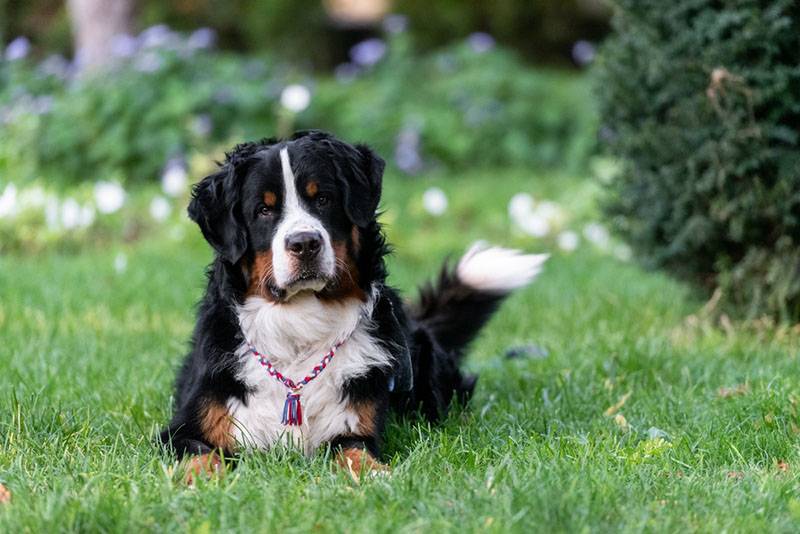
From childhood, a puppy is taught to walk on a leash next to the owner, and not to pull it. If you do not master this skill, then during the walk the owner will simply “fly” for a large pet wherever he wants.
It is important that the Bernese Mountain Dog has its own place in the house. For him, you can buy a rug or sunbed. It must be placed where it is warm and there are no drafts. Accustom the animal to its place from a very early age. The Sennenhund must immediately understand that it is impossible to sleep on the owner’s bed.
Also, the dog should purchase its own dishes – for food and water. It is advisable to immediately make it clear to the pet that it is not permissible to beg for food from the table.
Keeping and caring for the Bernese Mountain Dog
The long and thick coat of the Bernese Mountain Dog requires quite careful attention – it is better to comb it 2-3 times a week, using a special brush. During the period of active molting, enhanced care is needed – the procedure is carried out every day. For feathering on the legs and abdomen, a slicker with metal or silicone teeth is used, which will help to avoid the appearance of tangles. It is not recommended to cut out already formed tangles, it is better to try to untangle them.
Often bathing representatives of the Bernese Mountain Dog breed is not worth it. Enough 1-2 times a month. To do this, buy shampoos for dogs. After washing, the dog is wiped with a dry towel. While the animal’s coat is wet, make sure that it does not sit in a draft.
After each walk, the paws are washed, carefully cleaning the dirt between the fingers. In the winter season, the paws are washed with soap without fail, as the roads are sprinkled with reagents that corrode the skin and contribute to the formation of wounds and cracks.
It is advisable to purchase special tools – for example, wax. It protects the paws from harmful chemicals.
The claws of the Bernese Mountain Dog, like other dogs, are cut as needed with the help of nail clippers. Pets actively walking on the street usually need this procedure less often – they grind them on the ground or asphalt.
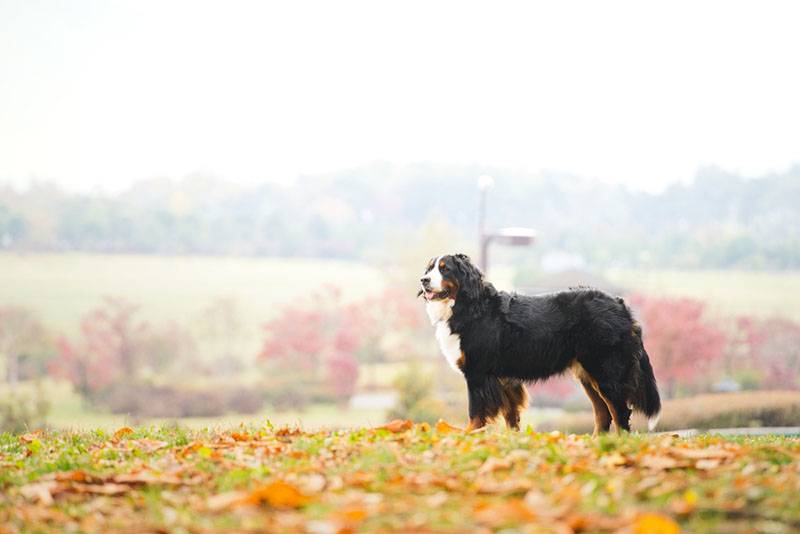
Ears also need care. After each trip to the street they are examined for the presence of ticks and other parasites. Clean them with veterinary lotions.
If during the examination some inflammation is found in the auricles, then you should consult a doctor as soon as possible to find out the cause.
The teeth of a dog are cleaned, just like a person, every day. To do this, use special brushes or small human teeth.
Bernese Mountain Dogs do not tolerate extreme heat well. The fault is their thick coat with a dense undercoat. In stuffy weather, it is not recommended to take them outside for a long time. It is better to give your pet the opportunity to rest in a well-ventilated area and provide him with constant access to clean water.
But in the winter season, the Bernese Mountain Dogs feel great and are delighted with a walk through a snow-covered forest or park. They love outdoor activities, they are often taken with them on hikes, travels, and picnics. The dog loves to swim in open water.
Food
Complete and regular nutrition is the basis of a pet’s health. The owner can choose one of several types of feeding for his four-legged friend:
- Natural products;
- Dry prepared rations;
- Canned food.
First of all, food should be balanced. That is, contain the optimal combination of proteins, fats, carbohydrates, vitamins and minerals.
If the owner of the Bernese Mountain Dog decided to choose natural food for his pet, then he will calculate the balance of proteins, fats and carbohydrates on his own. This process is quite complex and lengthy. For beginners, it is better to turn to professional nutritionists. The diet is selected for each dog on an individual basis, based on the following parameters: its breed, weight, age, health status and lifestyle.
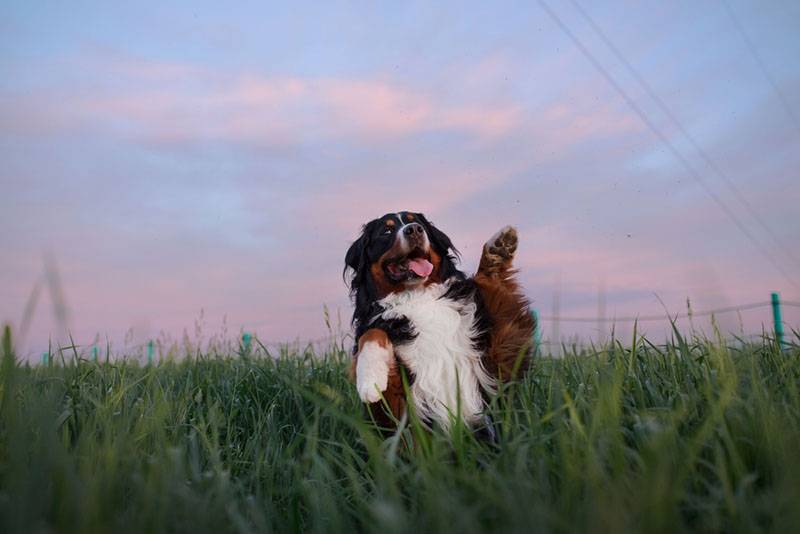
With a natural type of feeding, about a third of the diet is lean meat. About 10-15% – cereals – cereals cooked in water. Mostly cooked buckwheat and rice. It is acceptable to use pasta, potatoes and sweet potatoes. Salmon and sunflower oils are used as a source of fats. It is recommended to give the animal vitamin-mineral complexes with natural nutrition. They are prescribed by a veterinarian. Often, pets that are fed natural food are deficient in iodine and zinc. To make up for it, experts advise eating kelp, beef kidneys and hearts.
With ready-made rations, everything is much easier. Among them there are both complete and non-complete types of feed. All information about the product is indicated by the manufacturer on the packaging. Before buying, you need to carefully study it.
The difference is that the former contain all the necessary substances and trace elements, while the latter require the additional use of various vitamin complexes and nutritional supplements.For any type of diet, a nutritionist calculates the daily intake of food.
After the dog has eaten, the bowl is removed immediately. Water must be available at all times.
It is unacceptable to feed dogs with certain types of food. This can lead to very negative consequences. For example, they are deadly – garlic, raw fish and pork, grapes, bones, chocolate. In no case should you give fried, salted and smoked. Eating raw meat can be fraught with the appearance of parasites – helminths. In addition, such foods are much more difficult to digest.
Offal, in particular the liver, is recommended to be consumed in moderation. There is a lot of vitamin A in such food, and the needs of the animal’s body in it are very low. Often there is hypervitaminosis, which can cause damage to cartilage tissue.
The optimal number of meals for an adult is two. Puppies are fed much more often – 3-5 times a day. As you grow older, the number of receptions decreases. It is recommended to feed the dog after she has walked outside.
If there is a predisposition to excess weight, then it is worth strictly controlling the caloric content of food consumed. In this case, you should use treats as little as possible as rewards, reduce portions, and reduce fat intake. The diet in this case is calculated by the nutritionist individually.
Health of the Bernese Mountain Dog
The following types of diseases are most often diagnosed in the Bernese Mountain Dog:
- Diseases of the musculoskeletal system;
- Violation of blood clotting;
- Problems with the organs of vision (retinal atrophy, cataracts);
- Heatstroke (overheating);
- Oncological diseases.
Cancer is considered one of the most common causes of death for dogs of all breeds, but Bernese Mountain Dogs die from it more often than others. They are prone to various types of cancer, including malignant histiocytosis, mast cell tumors, lymphosarcoma, and osteosarcoma. It was a representative of this breed – a dog named Dylan – who became the first dog who underwent chemotherapy. His treatment was successful.
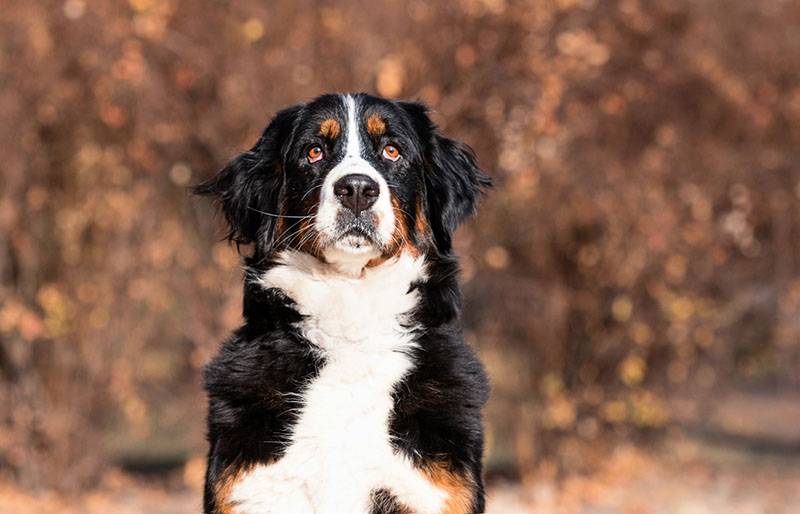
The death rate among Bernese Mountain Dogs is unusually high due to problems with the musculoskeletal system. Their owners are much more likely to go to clinics with diseases such as cruciate ligament rupture, arthritis, and hip dysplasia. The age of diagnosing problems is extremely low – all these diseases can already be present in a young individual. The average age of patients is 4 years. For animals with disorders of the musculoskeletal system, ramps are purchased for lifting into a car or into a house.
In order to timely detect the presence of a particular disease in the Bernese Mountain Dog, it is necessary to undergo a medical examination in a timely manner. Regular examinations will allow you to identify any disease at an early stage and cure it.
It is recommended that you vaccinate your pet according to the vaccination schedule.
Story
The Bernese Mountain Dog belongs to very ancient breeds. There is an assumption that their ancestors were Molossians – fighting dogs of Roman soldiers who invaded the territory of present-day Switzerland before our era. They were originally farm dogs and lived in an agricultural region near Bern that specialized in the production of cheese and chocolate.
In those days, these animals were engaged in grazing and driving cattle, guarding farm yards from predators. They were also actively used as traction dogs – powerful dogs easily transported carts with milk and cheese.
Despite the great benefit that tetrapods brought to people, by the 1800s their number had decreased several times. They were replaced by the St. Bernards .
In 1892, the owner of a hotel in Burgdorf, Franz Schertenleib, acquired a Sennenhund and was so impressed with the dog that he wanted to restore their population. He began an active search for individuals capable of participating in breeding.
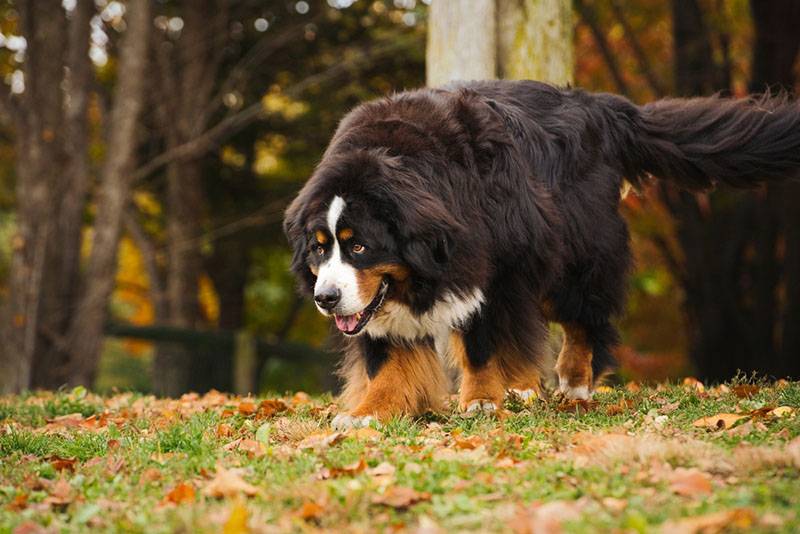
In 1907, the first club of Bernese Mountain Dog lovers was created under the leadership of Professor of Geology Albert Heim. In the same year, the first standard was released.
Until 1908, the breed was called “dürbahler”, after the place where they were first shown – in a small area located south of Bern. It was Professor Albert Heim who suggested changing the name to Sennenhund. He believed that it fully reflects their true purpose and origin. “Senne” – translated from German means “pasture”, “hund” – “hound”.
By 1910, there were 107 officially registered Bernese Mountain Dogs.
Dogs came to America in 1926, when a resident of Kansas brought several animals to his country.
In the 1940s, a random crossing with the Newfoundlands occurred , which made it possible to improve the breed qualities – the pets became more balanced and calm.
The peak of popularity of the Bernese Mountain Dog falls on the 1980s – they become in demand among breeders all over the world.
Photo of Bernese Mountain Dog
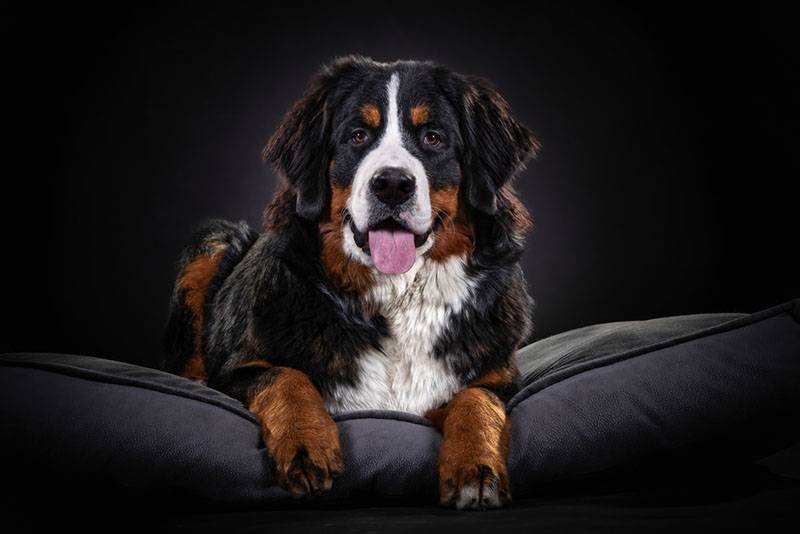
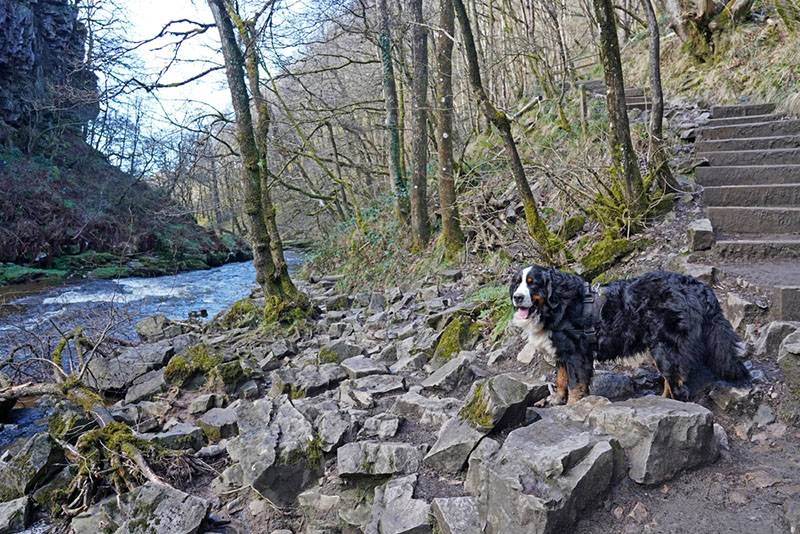
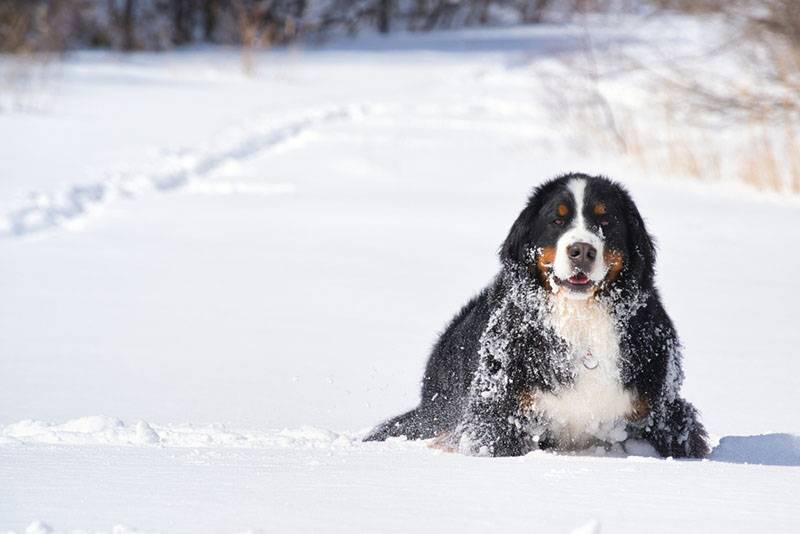
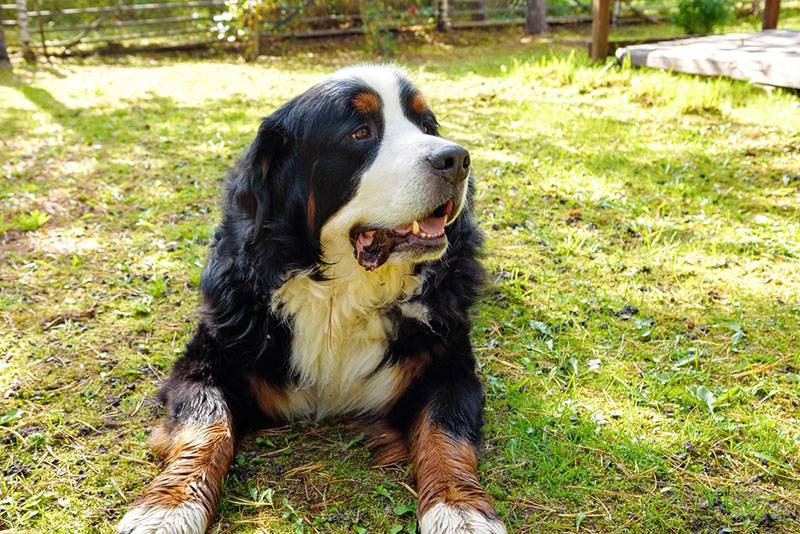
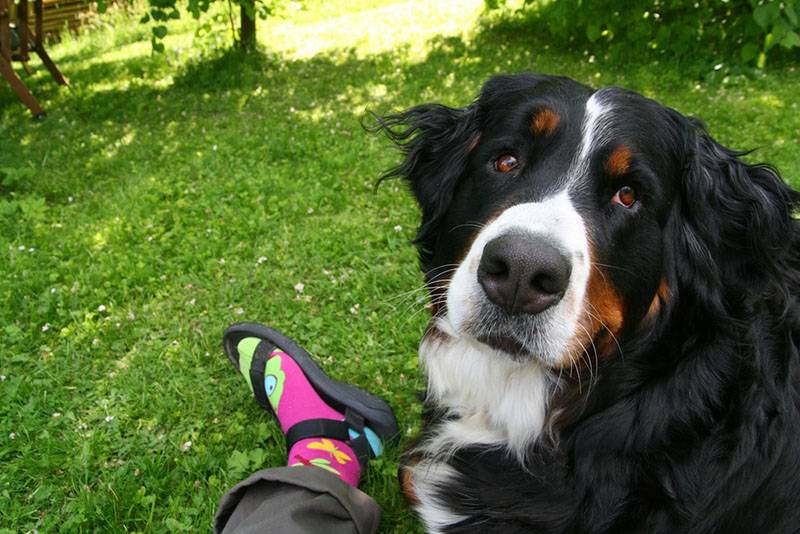
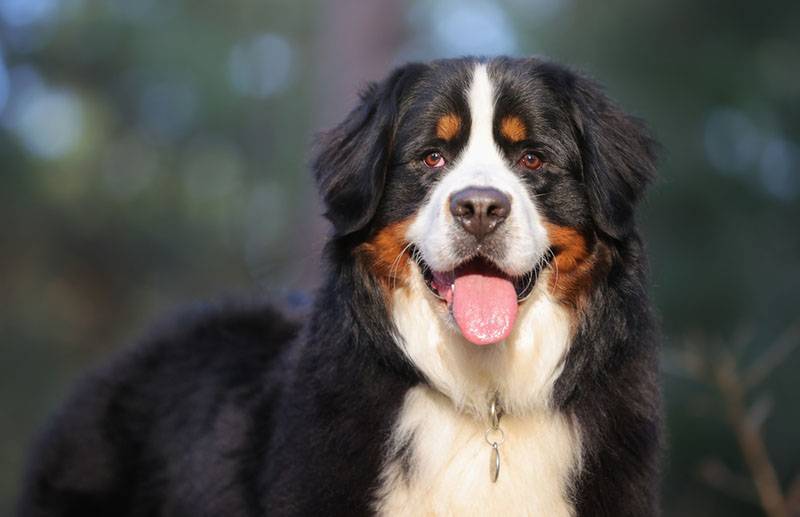
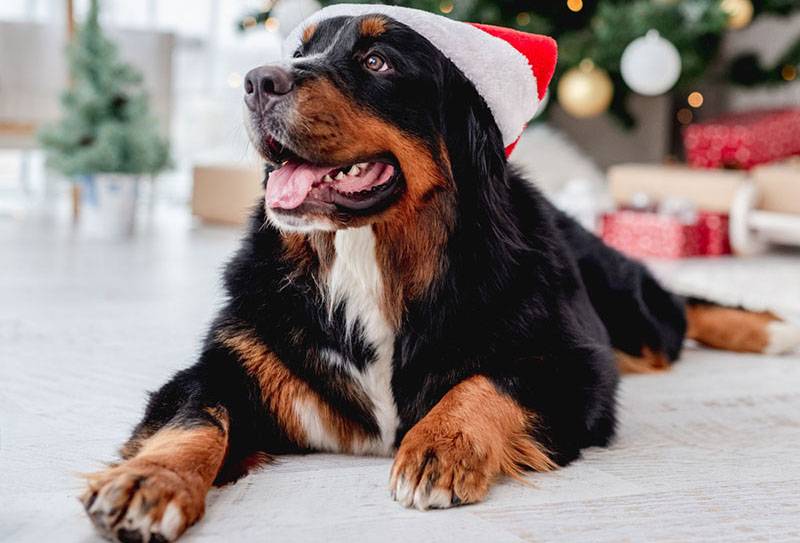
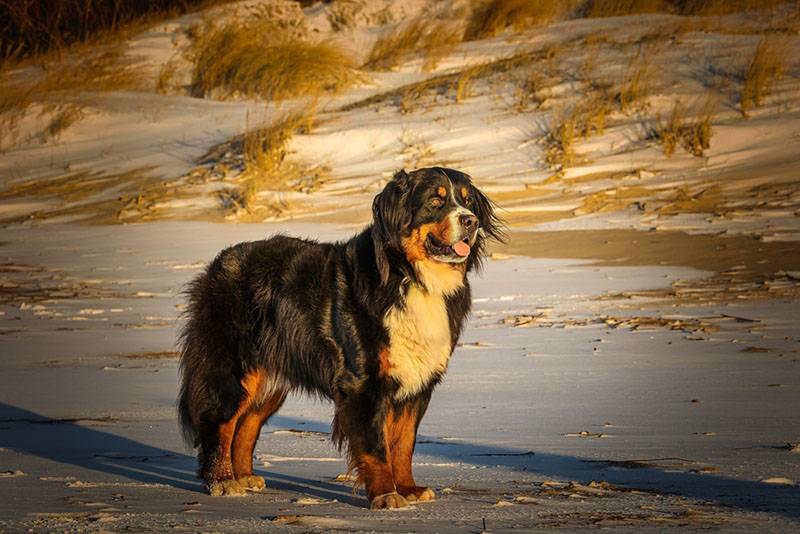
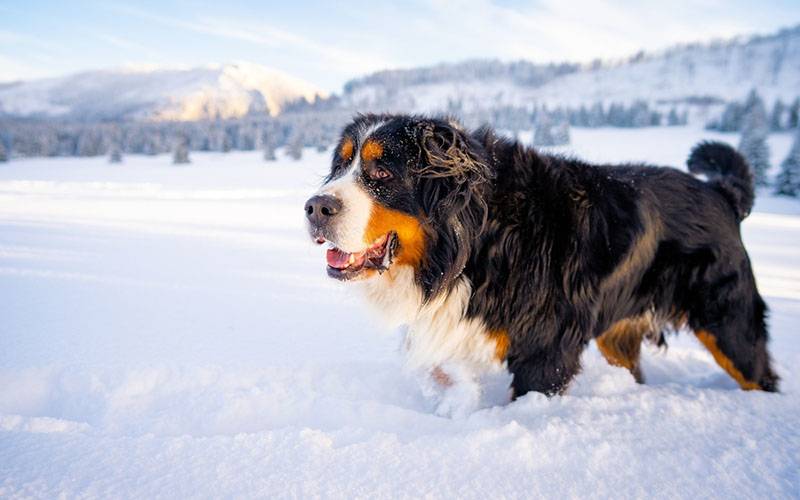
Who is this breed for?
The Bernese Mountain Dog is suitable for a person who:
- Large dog required
- It will be easy to regularly care for a thick coat;
- Need a non-aggressive and peaceful pet that responds well to other pets;
- It is not difficult to devote enough time to regular exercise.
This breed is not suitable for the owner:
- Having a small apartment or house;
- Not ready for active molting;
- Often absent from home;
- Unable to devote enough time to the health of the dog and take him to appointments with specialists.
The Bernese Mountain Dog is well suited to outdoor recreation, including winter. It is recommended to start it for people who lead an active lifestyle – often go on picnics, pick mushrooms, go fishing, go to the mountains.
Famous dogs
These animals are known primarily as excellent rescuers. A lot of cases have been recorded when the Bernese Mountain Dogs rescued their owners and strangers from trouble.
For example, in 2015, a dog named Niko rescued several people who were swept away by the California Current.
A female named Bela pulled her owner Chris Larock out of a burning house. Without the help of a four-legged friend, Chris most likely died, because due to his injuries he could not get out on his own.
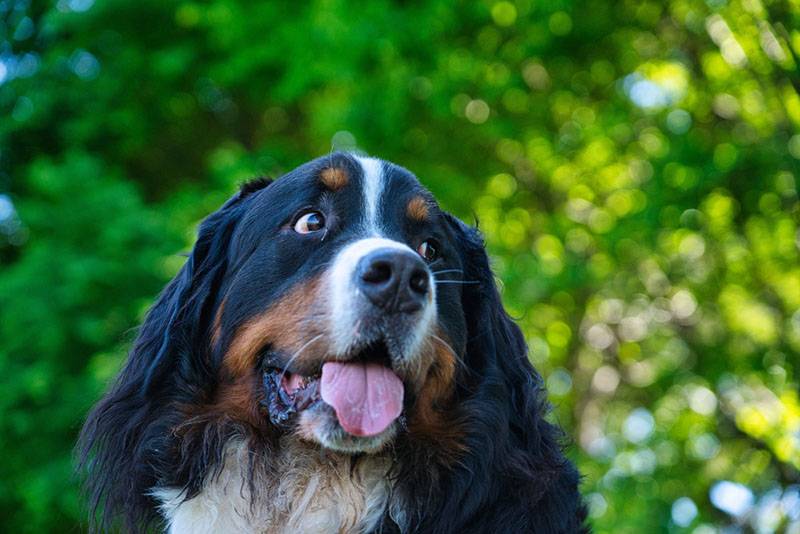
How to choose a puppy
When choosing a baby, you should pay attention to several points. The puppy is carefully examined and felt – paws, stomach, tail. The head must be correct. The eyes of a healthy dog cannot be cloudy.
In males, you need to check the usefulness of the development of the testes.
Professional breeders are required to provide buyers with the following:
- Veterinary passport (ideally – international standard);
- Metrica (a document on the basis of which a pedigree will be drawn up in the future).
In addition, in nurseries they put a brand on the baby. It is usually located either in the groin or on the inside of the ear. The stigma is considered the main method of identification in the all-Russian cynological system. It can be used to determine in which nursery the dog was bred.
Photos of Bernese Mountain Dog puppies
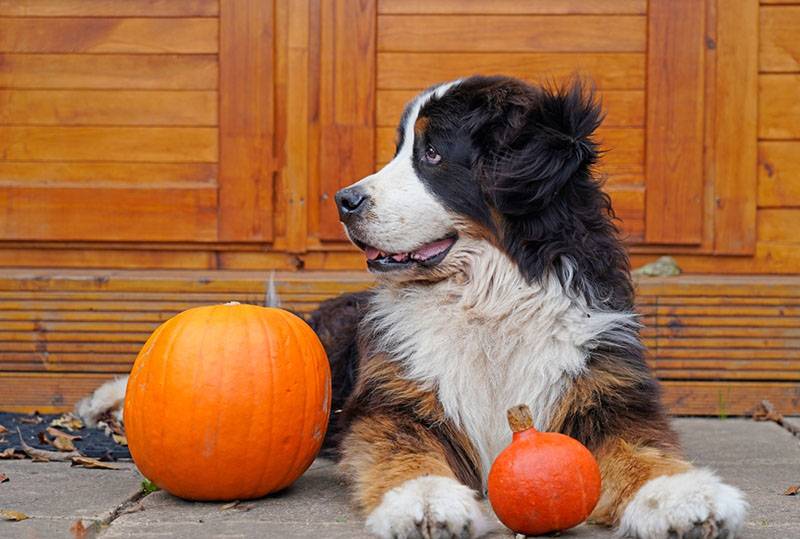
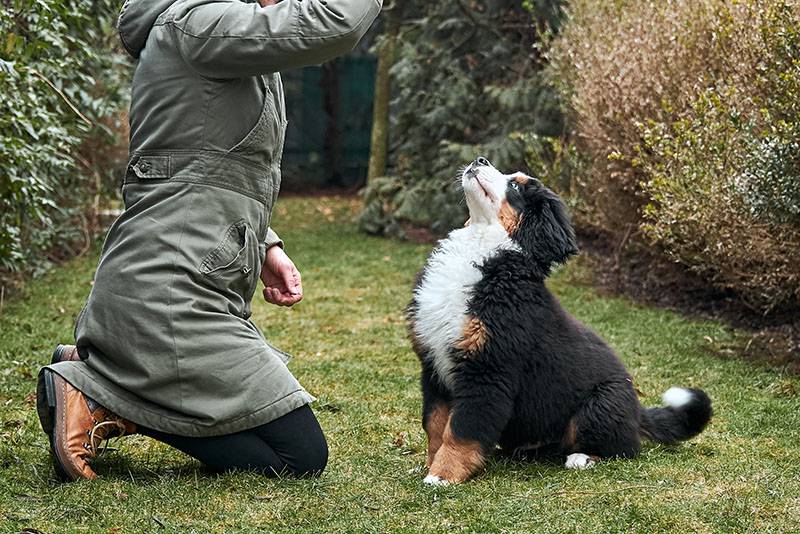
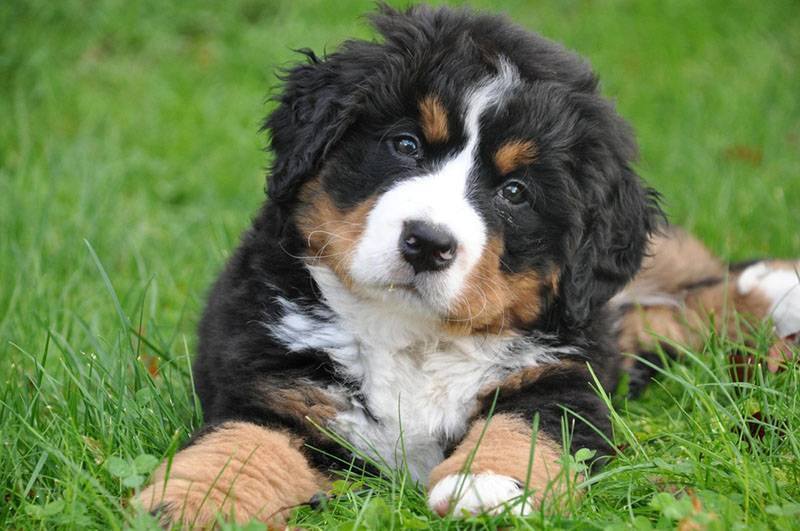
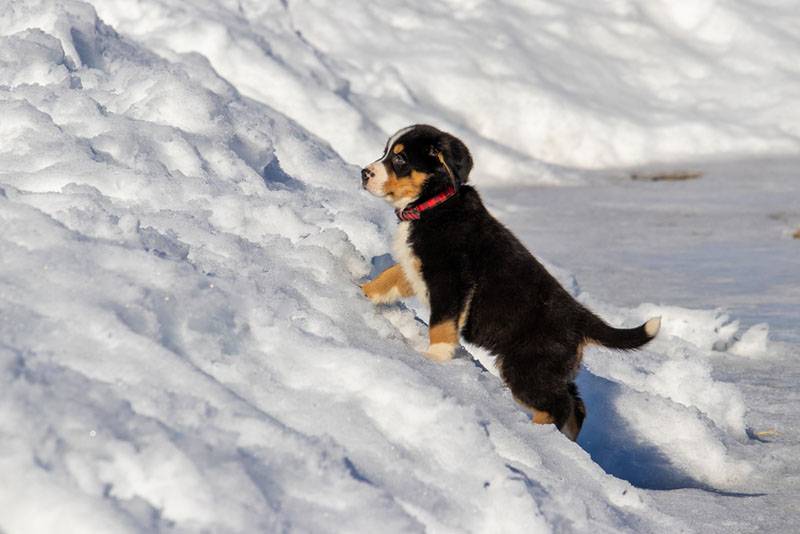
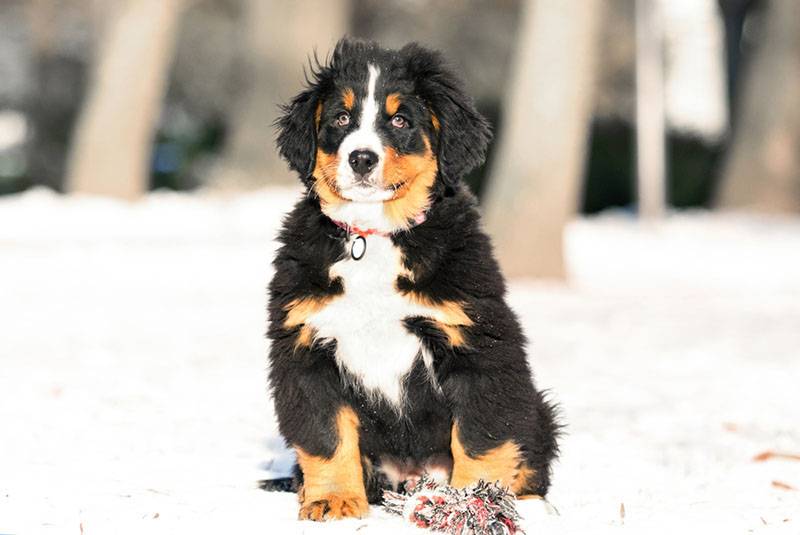
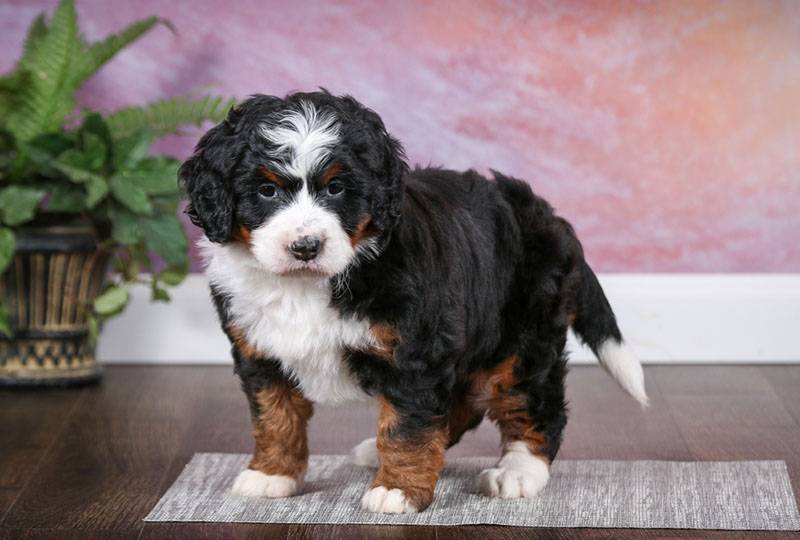
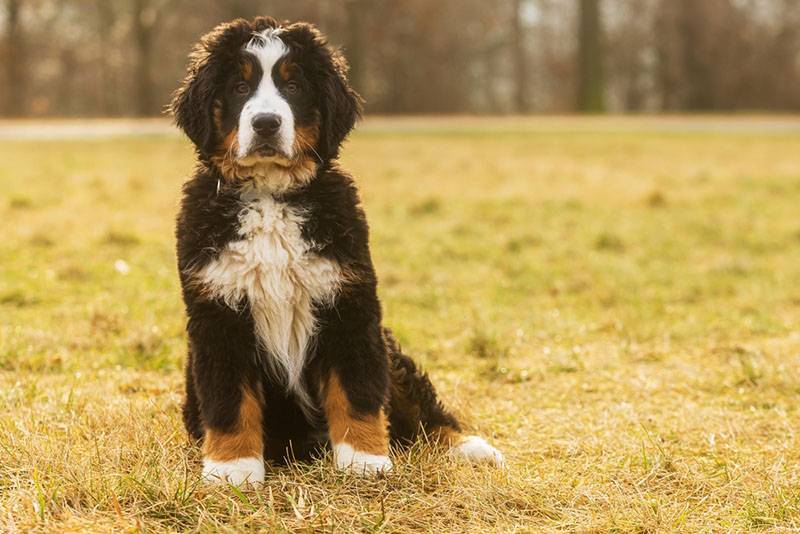
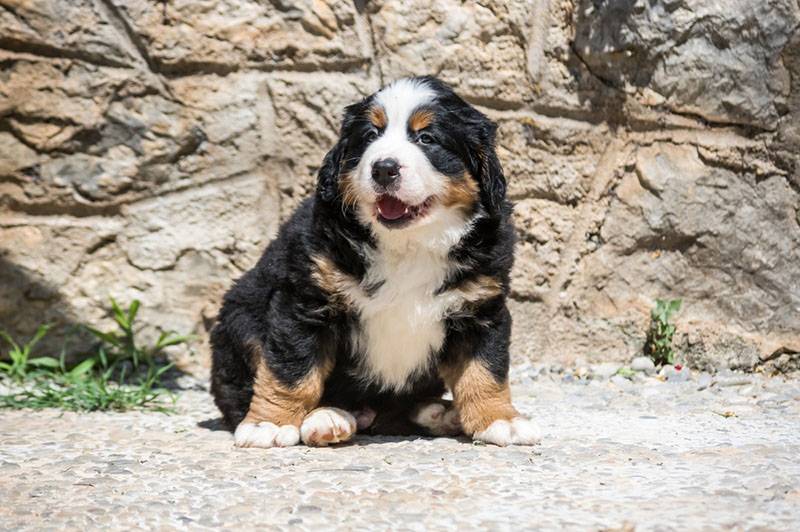
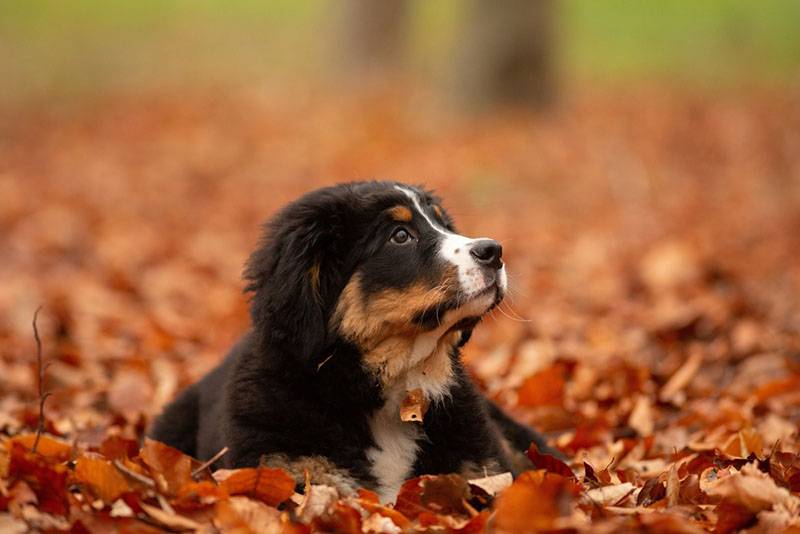
Owner’s personal experience
We got acquainted with the reviews of the owners of the Bernese Mountain Dogs. Most of them note that the dog is different:
- High level of intelligence;
- Great love for children (including strangers);
- devotion and fidelity;
- Friendliness and complete lack of aggression;
- Unpretentiousness in nutrition.
Of the most unpleasant moments, excessive molting is distinguished. If the animal is not combed at least once every two days, then the wool will be everywhere – on furniture, on carpets, on clothes.
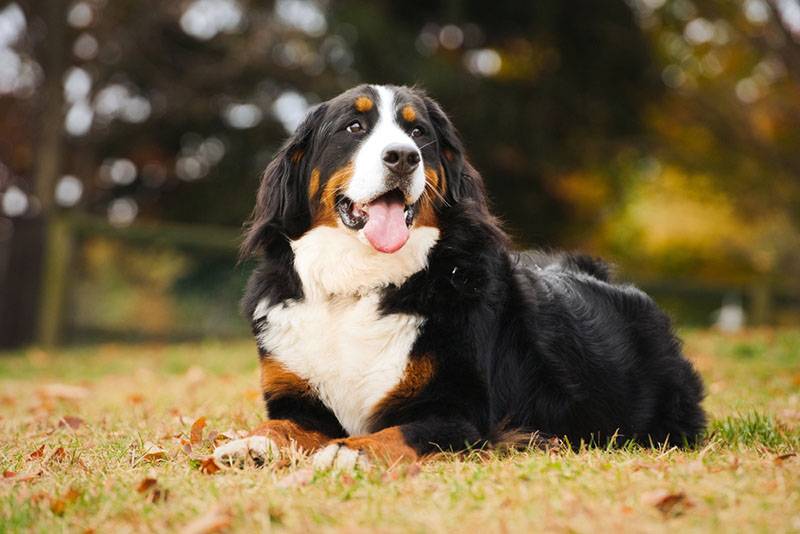
The owners of this breed note that Bernese Mountain Dogs make excellent family pets. The main thing is to devote enough time to the upbringing and socialization of the dog. He must master the entire basic set of commands, and then the owner will not have problems with him either on a walk or at home.
The health of the Bernese Mountain Dog needs to be paid attention. The experience of people suggests that most often such pets are diagnosed with cancer and problems with the musculoskeletal system.
Bernese mountain dog price
We conducted surveys: we contacted some Bernese Mountain Dog breeders and found out how much these dogs cost. The price depends on several things. If the baby has documents – a metric and a veterinary passport, then it will cost more. All this indicates that the pet was born from thoroughbred parents. Females always cost more than males.
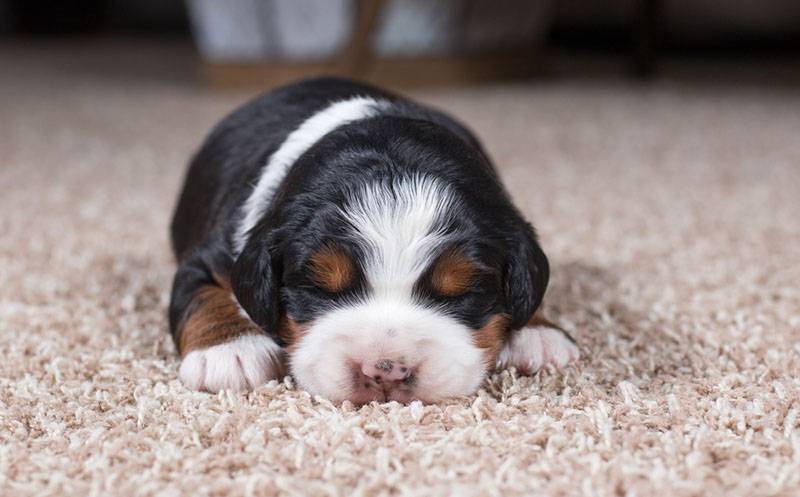
The average price for a Bernese Mountain Dog puppy in a kennel usually ranges from 40 to 60 thousand. The offspring, which was born from parents who are winners of various exhibitions, will cost more – 100-120 thousand rubles.
On the ad site you can find a healthy baby for 30-45 thousand rubles.
Bernese Mountain Dog – Video



